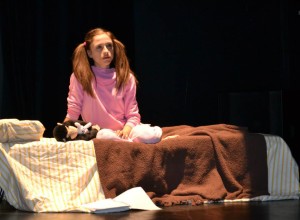Anita Majumdar’s Double Bill a the GCTC: One good, one not-so-good.
For the Ottawa Citizen.
Photo, Andrew Alexander. Featuring Anita Majumdar.
Life by its nature is a fraught affair. Try living it as a female Indo-Canadian teenager at predominantly white Port Moody Senior Secondary in British Columbia.
That’s the setting for Anita Majumdar’s Fish Eyes and Boys with Cars, the simultaneously wonderful and disappointing double bill at the Great Canadian Theatre Company.
Majumdar wrote, choreographed and performs both shows. She blends exquisite Indian dance and acting that’s riveting in Fish Eyes but less so in Boys with Cars with issues ranging from teenaged (and, by extension, human) angst to patriarchy and cultural appropriation.
Fish Eyes, which Majumdar has been performing for a decade, finds 17-year old Meena despairing that “everyone’s living the dream” – as in making out and drinking beer – while she’s preparing to participate in an Indian dance festival.
Next to Normal; a musical voyage into the depths of a tortured soul!
Photo of the Cast, from the Royal Ottawa Hospital site.
Diana, a mother suffering from depression and PTSD, is portrayed by singer/actress Skye MacDiarmid who immersed herself in this difficult role with passion, and total conviction, revealing her strong voice and enormous acting skills from the very first moments. This immediate burst of talent creates a break between the sadness of the content and the uplifting form of the performance and it gives us strength to continue watching, after all the subject matter is not easy. Fifteen years after the death of her 8 month old son, Diana remains traumatized by the event and never seems to have recovered. On the contrary, theC. Lee Bates staging and the music, directed by Paul Legault, fore ground the hallucinatory presence of this “dead” son floating around the stage singing “I’m alive” , taunting the still grieving mother who cannot get the image of this young man out of her head as he clings to her memories and won’t permit her to let go of this past that is tearing her apart. That is the narrative essence of this Tony Award winning performance Next to Normal, now playing at the Gladstone until Saturday the 18th.
Villes: Collection particulière. A production of the Théâtre de la Pire Espèce : visual genius on the stage of Lasalle secondary public school.
Photo, Pire Espece, Olivier Ducas..le magicien!
La Nouvelle scène is still a hole in the ground but it is on the way to being built, said Anne Marie White , playwright, director and artistic director of the Théâtre Trillium as she introduced le Théâtre de la Pire Espèce….For the moment , all the Franco-ontarian theatres are performing at the LaSalle School on Saint Patrick street.
This time, Trillium has us sitting with the artists/technicians on the stage, as Wajdi Mouawad loves to have us do..and we were close to the inventions and magic moments, the machines, the sound equipment, the props and everthing that Olivier Ducas brought to life during this highly original spectacle..
A most original production that creates a whole universe of imaginary spaces and forms, linked to the conscience of Olivier Ducas who has reimagined the world, and set it up using contemporary forms and images taken from film, from computer images, from graphic design, from web cams, from spy cameras, from animated film techniques; a great mass of textures, colours, styles that meet and melt and explode…as the narrator who wields the camera tells us the story of his collection of towns, their different temperments, their forms, the way their elements are integrated..it is theatre with no characters, no narrative, no psychological types, no action, no elements that come from novels…but this is PURE cinema—and abstraction as seen by Kandinsky_ pure form, pure colour, ..space, texture, sound, light the essence of modern art..quite a magnificent creation ..and we are the "flâneur " in his little collection of cities. Baudrillard is in the wings, so is Baudelaire , watching, wondering, taking it easy, enjoying the surfaces, the graffiti, the sounds , the new urban space devoid of living creatures..DONT miss this…Le théâtre de la pire espèce is a marvellous bundle of youthful creative energy from Montréal, that we hope to see again in Ottawa.
Anglophones and Francophones…will enjoy this…
l’École des femmes : Un joyeuse adaptation hybride, portée par le metteur en scene et le jeu magistral d’Andy Massingham.
Version posted on the site theatredublog.unblog.fr
Photo. David Whitely.
Cette traduction/adaptation de L’École des femmes par David Whitely, est une tentative de rendre la langue de Molière accessible à un public anglophone qui connaît mal le théâtre français du dix-septième siècle. Au départ on ressent la présence d’un étrange anachronisme entre une mise en scène (John P. Kelly) presque « classique » et le rythme naturel des répliques anglaises de style populaire au XXIe siècle écrites en alexandrins! En effet le XVIIe (en France) et le XXIe siècle (au Canada) ont réalisé une fusion qui finit par fonctionner assez bien, même si, pour certains puristes, cette rencontre linguistique pourrait paraître indigeste. Malgré tout, l’événement, et le texte semblent avoir respecté la sensibilité de Molière. Cette langue contemporaine peu raffinée, semble faire écho au côté frondeur de l’École… qui a refusé les règles d’Horace et choqué certaines oreilles sensibles de la cour et des Précieux « ridicules » (voir La Critique de l’École des femmes).




